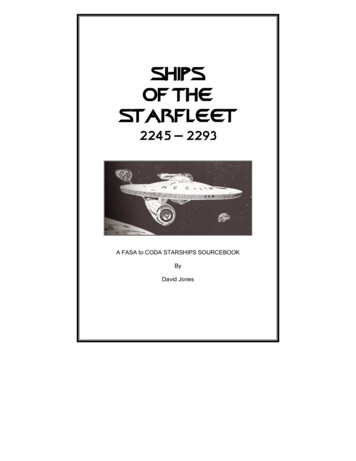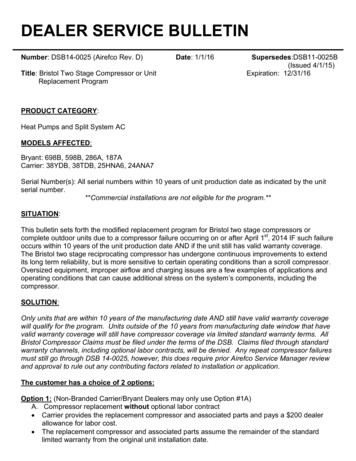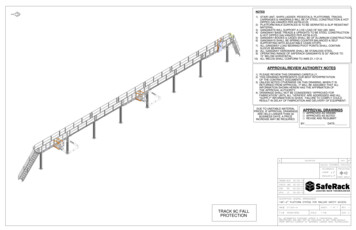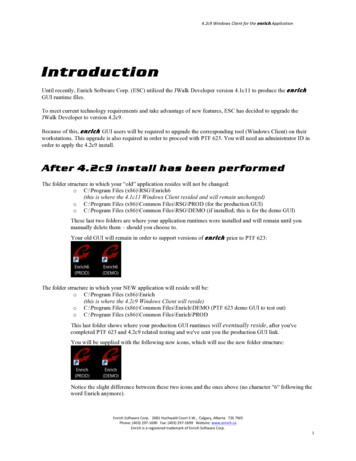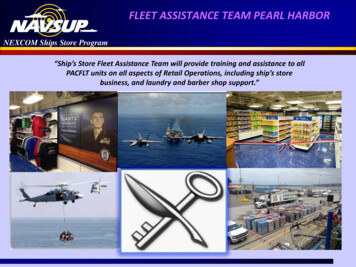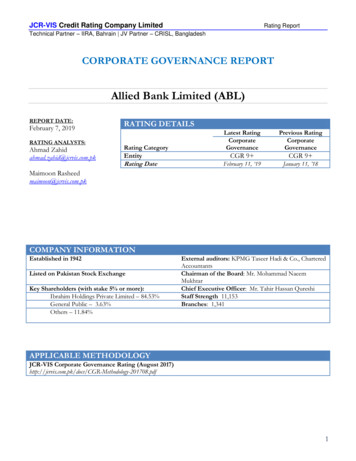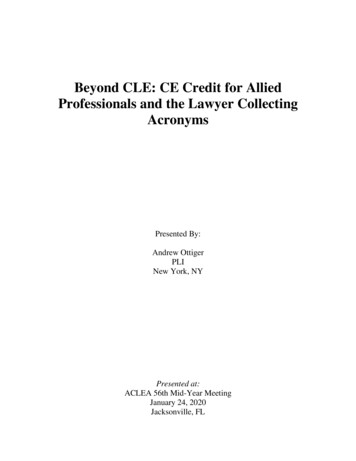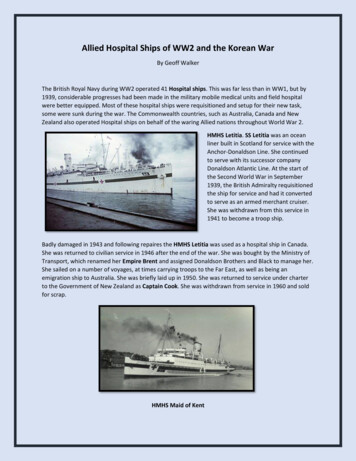
Transcription
Allied Hospital Ships of WW2 and the Korean WarBy Geoff WalkerThe British Royal Navy during WW2 operated 41 Hospital ships. This was far less than in WW1, but by1939, considerable progresses had been made in the military mobile medical units and field hospitalwere better equipped. Most of these hospital ships were requisitioned and setup for their new task,some were sunk during the war. The Commonwealth countries, such as Australia, Canada and NewZealand also operated Hospital ships on behalf of the waring Allied nations throughout World War 2.HMHS Letitia. SS Letitia was an oceanliner built in Scotland for service with theAnchor-Donaldson Line. She continuedto serve with its successor companyDonaldson Atlantic Line. At the start ofthe Second World War in September1939, the British Admiralty requisitionedthe ship for service and had it convertedto serve as an armed merchant cruiser.She was withdrawn from this service in1941 to become a troop ship.Badly damaged in 1943 and following repaires the HMHS Letitia was used as a hospital ship in Canada.She was returned to civilian service in 1946 after the end of the war. She was bought by the Ministry ofTransport, which renamed her Empire Brent and assigned Donaldson Brothers and Black to manage her.She sailed on a number of voyages, at times carrying troops to the Far East, as well as being anemigration ship to Australia. She was briefly laid up in 1950. She was returned to service under charterto the Government of New Zealand as Captain Cook. She was withdrawn from service in 1960 and soldfor scrap.HMHS Maid of Kent
HMHS Maid of Kent. Used as a hospital ship between 1939 – 40. SS Maid of Kent made her way toFolkestone as soon the United Kingdom declared war on Germany. She was taken over by the RoyalNavy and designated as a hospital ship and made her way from Newhaven to Dieppe.Throughout May of 1940, she made several trips to and back carrying hundreds of wounded. 18 May, abomb dropped nearby HMHS Maid of Kent, but she was unable to relocate, three days later, on 21 May,a bomb from the Luftwaffe air raid hit her engine room which cause a fire aboard the ship. She sank thatday but was later raised by the Germans and moved into deeper water.AHS Manunda was an Australianregistered and crewed passenger ship,operated by the Adelaide SteamshipCompany, which was converted to ahospital ship in 1940. During the warManunda saw service in both the MiddleEast and Pacific Campaigns, specificallyNew Guinea. She resumed her passengerduties after the war, before being sold to aJapanese company and finally broken up in1957.The declaration of war saw Manunda fitted out as DEMS ship (Defensively Equipped Merchant Ship),under the control of the Australian Shipping Control Board. She was converted into a hospital ship atSydney in compliance with the Geneva Convention Regulations and was taken over by the authorities on25 May 1940 and entered service as AHS Manunda on 22 July 1940. AHS Manunda sailed on ashakedown cruise to Darwin, Port Moresby and returned to Sydney, before heading for Suez in theMiddle East (she made four trips to the Middle East and Mediterranean between November 1940 andSeptember 1941). She was then dispatched to Darwin. On the morning of 19 February 1942, AHSManunda was damaged during the Japanese air raids on Darwin, despite her highly prominent red crossmarkings on a white background. 12 members of the ship's crew and hospital staff were killed, 19 otherswere seriously wounded and another 40 or so received minor wounds.After a refit in Adelaide, she went to Milne Bay in Papua New Guinea, where she acted as a floatinghospital for the Allied forces who were stationed there. She spent several nights in Milne Bay, duringattacks by Japanese warships, but her status as a hospital ship was, on this occasion honored byJapanese naval units, which raked her with searchlights on three nights running. She made a total of 27voyages from Milne Bay to Brisbane and Sydney transporting wounded troops. As the war continued,she was relocated as required and she followed the Allied forces the various islands around the Pacific.AHS Manunda's final wartime voyage was to New Zealand transporting civilian passengers. During thewar she carried approximately 30,000 casualties to safety. Following the Japanese surrender, AHSManunda was dispatched to Singapore to repatriate ex-POWs and civilian internees who had beenimprisoned in the notorious Changi Prison. She also sailed to Labuan in Borneo to pick up ex-POWs andcivilian internees from Batu Lintang camp.
AHS Manunda was decommissioned in September 1946 and refitted. She returned to service on 2 April1948, transporting passengers around the Australian coast. In September 1956 she was withdrawn fromservice, and she was broken up the next year in Japan, arriving in Osaka for scrapping on 18 June 1957.The AHS Manunda seen painted in her Hospital Ship colors.In 1923, the Blue Funnel Line, decided that a new vessel would be required to replace the ageing Charonon the Western Australia to Singapore trade. The vessel had to be capable of transporting a combinationof passengers, cargo, and livestock. She also had to have a flat bottom, capable of resting on mud flatsout of the water as the tidal variance in ports at the northern end of Western Australia was as great as 8meters.Australian Hospital Ship AHS Centaur was ahospital ship which was attacked and sunk bya Japanese submarine off the coast ofQueensland, Australia, on 14 May 1943. Ofthe 332 medical personnel and civilian crewaboard, 268 died, including 63 of the 65 armypersonnel on board at the time.Centaur, pictured left, was launched in 1924as a combination passenger liner andrefrigerated cargo ship, she operated abetween Western Australia and Singapore viathe Dutch East Indies’ Javanese ports, carryingpassengers, cargo, and livestock. At the start
of World War 2, Centaur was placed under British Admiralty control, but after being fitted withdefensive equipment, she was permitted to continue normal operations. In November 1941, the shiprescued German survivors of the engagement between Kormoran and HMAS Sydney. Centaur wasrelocated to Australia's east coast in October 1942 and used to transport supplies, equipment andpersonnel between Australia, and New Guinea.In January 1943, Centaur was handed over to the Australian military for conversion to a hospital ship, asher smaller size made her more conducive for operating in Southeast Asia. The refit was completed inMarch, and the ship undertook a trial voyage: transporting wounded from Townsville to Brisbane, thenfrom Port Moresby to Brisbane. After replenishing in Sydney, now the AHS Centaur, embarked the2/12th Field Ambulance for transport to New Guinea, and sailed on 12 May. Before dawn on 14 May1943, during her second voyage, AHS Centaur was torpedoed and sunk by a Japanese submarine offMoreton Island, Queensland.The torpedo struck the port side oil fuel tank approximately 2 meters below the waterline, creating ahole 8 to 10 meters across, igniting the fuel, and setting the ship on fire from the bridge aft. Many ofthose on board were immediately killed by concussion or perished in the raging inferno. AHS Centaurquickly took on water through the place of the torpedo impact, rolled to port, then sank bow-first,submerging completely in less than three minutes. The rapid sinking prevented the deployment oflifeboats, although two broke adrift from AHS Centaur as she sank, along with several damaged liferafts.The incident resulted in public outrage as attacking a hospital ship is considered a war crime under the1907 Hague Convention. Protests were made by the Australian and British governments to Japan andefforts were made to discover the people responsible so they could be tried at a war crimes tribunal, butwithout success. The Japanese issued an official statement denying any responsibility for the attack. TheJapanese maintained this stance after the war was over, but after many years of investigation andresearch, it was concluded that the Japanese submarine I-176 although never proved beyond doubt,was most likely the culprit.Australian politicians urged the public to use their rage to expand the war effort, and AHS Centaurbecame a national symbol of Australia's determination to defeat what appeared to be a brutal anduncompromising enemy. The Australian Government produced posters depicting the sinking, whichcalled for Australians to "Avenge the Nurses" by working to produce materiel, purchasing war bonds, orenlisting in the armed forces.The propaganda poster which was issued by the AustralianAuthorities calling for Australians to avenge the sinking ofhospital ship AHS Centaur.Torpedo attacks in Australian waters was common at this time,with 27 Japanese submarines operating in Australian watersbetween June 1942 and December 1944. These submarinesattacked almost 50 merchant vessels, 20 ships confirmed to besunk as result of a Japanese attack, plus 9 more unconfirmed.This was part of a concentrated effort to disrupt supplyconvoys from Australia to New Guinea.
HMHS Newfoundland departing Algiers harbor in 1943.HMHS Newfoundland was a British Royal Mail Ship that was requisitioned as a hospital ship in theWorld War 2. She was sunk in 1943 in an air attack whilst serving in the Mediterranean. HMHSNewfoundland spent the first part of World War 2 on her peacetime route, carrying wounded troopsfrom the UK to Canada, and bringing the rehabilitated troops back home.After the Allied invasion of Italy in September 1943, HMHS Newfoundland was assigned as the hospitalship of the Eighth Army and was one of two hospital ships sent to deliver 103 American nurses to theSalerno beaches on 12 September. The hospital ships were attacked twice that day by dive bombers,and by evening they were joined by a third hospital ship. Concerned by the number of near misses, itwas decided to move the ships out to sea and anchor there for the night. All three ships were brightlyilluminated and carried standard Red Cross markings to identify them as hospital ships, and theirprotection under the Geneva Convention.At 5:00 a.m. on 13 September HMHS Newfoundland was hit by a Henschel Hs 293 air-launched glidebomb 40 nautical miles offshore of Salerno. The bomb was launched by a Dornier Do 217 bomberbelonging to KG 100. It struck on the boat deck, abaft of the bridge. The ship was only carrying twopatients and 34 crew members. Communications were lost but, more importantly, the firefightingequipment was completely destroyed. By now the ship had caught fire. There was another explosionand it became clear that the oil tanks had also caught fire. The injured crew left the ship and 12 crewmembers battled the fire for a further 36 hours. The ship was beyond repair and was towed further outto sea and intentionally scuttled the day after the attack by the destroyer Plunkett. Of the people onboard, six of the British staff nurses and all of the medical officers had been killed.
SS Takliwa was a 7,936 GRT cargo liner which was built in 1924 by Barclay, Curle & Co Ltd, Glasgow, forthe British India Steam Navigation Company. She was converted to a hospital ship during World War 2,serving until she was wrecked in October 1945.HMHS Takliwa during her cruising days prior to conversion as a Hospital Ship.SS Takliwa was employed onthe Calcutta, India - Japanservice. In January 1927, shetransported troops of the 2ndBattalion, The Durham LightInfantry to Calcutta and thento Hong Kong. The ChineseCivil War was then brewing,and the troops were taken onto Shanghai.Takliwa served on the India Japan route until 1933. Shethen operated between theUnited Kingdom and Bombay, via Mombasa, Kenya. Takliwa was at Bombay when the Second WorldWar broke. In 1940, she was requisitioned by the Ministry of War Transport for use as a troopship, andbetween September 1939 and July 1943, she sailed the Indian Ocean. From July 1943 to August 1944,Takliwa was mostly sailing in the Mediterranean. On 11 November, Takliwa was damaged in an attackon the convoy by Dornier Do 217 aircraft. She put into Algiers for repairs. In August 1945, she took partin Operation Dragoon, although there is no record of how many troops she transported as a member ofConvoy TF 1. Upon completion of Operation Dragoon, she continued sailing the Mediterranean untilJune 1945, when she returned to Bombay.In 1945, she was converted to a hospital ship and assisted in the repatriation of prisoners of war fromHong Kong to India. She departed from Hong Kong on 5 October, on what was to be her final voyage. On16 October, whilst repatriating ex-PoWs from Hong Kong to Madras, HMHS Takliwa ran aground atIndira Point, Great Nicobar, in the AndamanIslands, and caught fire. A distress call wasissued which was answered by HMS Sainfoin.All 1,083 people on board were rescued.HMHS Takliwa burnt out and broke up, shebecame a total loss.Events in Greece hastened the completion ofthe conversion of the Maunganui to ahospital ship. The Prime Minister urged thesupervising committee to day-and-nightefforts to expedite her departure, and theDGMS was given a free hand to purchase all
the medical and surgical equipment necessary without having to await the approval of the PurchasingBoard. The estimated date for completion had been 15 May, but the ship was got ready by 21 April1941.This was made possible only by expeditious work in the conversion of the ship and the fortunateprocurement of equipment, some of which was not available in New Zealand. In the meantime, theBritish hospital ship Somersetshire had transported invalids to New Zealand from the Middle East inMarch 1941.The Maunganui under the terms of her requisition, was manned and operated by the Union Steam ShipCompany of New Zealand Ltd., the deck, engine, and providore departments being staffed by thecompany’s officers and the ratings being drawn from the New Zealand maritime unions. The medicalpersonnel were selected by the Director-General of Medical Services and the sisters were appointedfrom the New Zealand Army Nursing Service by the Matron-in-Chief.The staff of 104 medical officers, nursing sisters, and orderlies had been assembled at Trentham MilitaryCamp. On 18 and 21 April they embarked and on 22 April 1 NZHS Manganui left Wellington for Suez.The NZHS Maunganui was not a unit of 2 NZEF and the staffing and equipping of the ship remained aNew Zealand Army Medical Headquarters’ responsibility throughout the war. The NZHS Manganuiarrived at Suez on 22 May 1941The NZHS Maunganui was held at Suez until 10 June 1941 in order to take casualties from Greece, andCrete. Invalids embarked for the voyage to New Zealand numbered 338. An allocation of forty beds wasmade to the AIF, in view of the fact that on each voyage of the Australian hospital ship some beds werereserved for New Zealanders. Thus, on her first voyage the NZHS Maunganui took back a full load ofpatients, including many of the casualties from the Division’s first major actions. On the succeedingfourteen voyages she was always a full ship on her homeward run. On her outward trips, too, it wascustomary to pick up British invalids at Colombo and Bombay and take them to Egypt, where they weretransferred to a British hospital ship. Apart from about six weeks in 1942 when she was laid up foroverhaul, and a period in 1943 when, because of an accident to one of her propellers, she was takenfrom North Africa to the United Kingdom for repairs, the NZHS Maunganui rendered continuous service.The NZHS Maunganui alone, was not sufficient to bring back to New Zealand all the invalids from theMiddle East, especially after campaigns where casualties were heavy. Valuable assistance was renderedby the Australian hospital ship Wanganella, which carried many hundreds of New Zealanders, and bythe Netherlands hospital ship Oranje.NZHS Maunganui spent much of 1945 with the British Pacific Fleet. On her fifteenth voyage, beginningon 17 March 1945, the ship was diverted at Melbourne from the Middle East to the Pacific, and shewent on to Sydney, to Manus Island, to Leyte Island, where the ship functioned as a general hospital,from 13 April to 21 May before returning to Wellington. Leaving Wellington on 28 June, the ship againheaded for the Pacific and was the medical center for the British Pacific Fleet at Manus Island from 7 Julyto 18 August before moving on to Hong Kong and Formosa with the American Task Force 111, to pick uppatients from among the prisoners of war released from the Japanese. Most of these patients werebrought back to New Zealand on her return on 8 October.While at Leyte in the Philippine Islands on the fifteenth voyage the ship admitted 342 patients, most ofthem from other ships in the Fleet, which was anchored around the NZHS Maunganui. The ship was
used as a naval auxiliary hospital, half of the fleet being allotted to it and the other half to HMHSOxfordshire. Patients were discharged to their own ship or, if this had sailed, to a ship which acted as adepot ship. Some serious cases were transferred to ships going to Sydney, and patients were alsobrought back to Sydney in the hospital ship when she returned.At Manus on the sixteenth voyage the ship admitted and discharged 242 patients before sailing to HongKong, where 111 patients were embarked. Then 108 patients were embarked at Kiirun, Formosa, andlater another 156 at Manila on the voyage south again. A few were discharged at Hong Kong, Formosaand Manila, but 362 were brought back to New Zealand where, except for some Australians immediatelytransferred to a United States hospital ship to go to Sydney, they received hospital and convalescenttreatment before being finally repatriated to their own countries, most of them to the United Kingdomby the NZHS Maunganui on 23 November. The patients embarked at Hong Kong included civilians aswell as service patients, and many of those embarked at Formosa were British service personnel whohad been taken prisoner at the fall of Singapore. Those embarked at Manila included many Australiansfrom a United States hospital and a prisoner-of-war reception depot. They all rapidly increased theirweight and improved in health on the hospital ship, whose staff was kept busily occupied in theirtreatment. The NZHS Maunganui took the ex-prisoners of war to the United Kingdom on her finalvoyage beginning on 23 November 1945 and ending on 20 March 1946, when she brought back to NewZealand the last of 2 NZEF invalids from Italy and Egypt. By which time the number of patients carried,numbered 5677.In 1945 assistance in the return of invalids to New Zealand was given by several British hospital ships,which had throughout the war also carried New Zealand battle casualties on the lines of communicationon the North African and Palestine coasts and across the Mediterranean from Italy. Altogether, with theNZHS Maunganui as the mainstay and with the help of the Oranje and Wanganella and other Alliedhospital ships, a creditable record was maintained in the evacuation of sick and wounded throughoutthe war.AHS Wanganella pictured after conversion to a Hospital Ship in 1941
MV Wanganella was another Australian passenger ship, of 9,576 grt. Her conversion to a hospital shipwas completed on 19 May 1941 and her first voyage as HMAHS was to Singapore in July 1941 carryingthe 2/13th Australian General Hospital. The next voyage was to Suez to collect wounded for return toSydney and Brisbane. AHS Wanganella was at Port Tewfik during the bomb attack which seriouslydamaged and burnt out the British liner Georgic. After two more voyages to the Middle East the shipwas ordered to Port Moresby in May 1942 to collect injured for return to Australia, and to transport UScasualties from Townsville to the US 4th General Hospital which was temporarily housed in the newlyconstructed replacement for the Royal Melbourne Hospital.On her 13th voyage AHS Wanganella departed from Sydney in M
Allied Hospital Ships of WW2 and the Korean War By Geoff Walker The British Royal Navy during WW2 operated 41 Hospital ships. This was far less than in WW1, but by 1939, considerable progresses had been made in the military mobile medical units and field hospital were better equipped.

